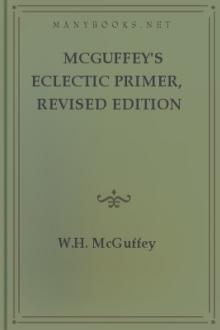Agriculture for Beginners, Daniel Harvey Hill [best ereader under 100 .txt] 📗

- Author: Daniel Harvey Hill
- Performer: -
Book online «Agriculture for Beginners, Daniel Harvey Hill [best ereader under 100 .txt] 📗». Author Daniel Harvey Hill
Cereal: the name given to grasses that are raised for the food contained in their seeds, such as corn, wheat, rice.
Cobalt: a poisonous chemical used to kill insects.
Cocoon: the case made by an insect to contain its larva or pupa.
Commercial fertilizer: an enriching plant food bought to improve soil.
Compact: a soil is said to be compact when the particles are closely packed.
Concentrated: when applied to food the word means that it contains much feeding value in small bulk.
Contagious: a disease is said to be contagious when it can be spread or carried from one individual to another.
Cross: the result of breeding two varieties of plant together.
Cross pollination: the pollination of a flower by pollen brought from a flower on some other plant.
Croup: the top of the hips.
Culture: the art of preparing ground for seed and raising crops by tillage.
Curb disease: a swelling on the back part of the hind leg of a horse just behind the lowest part of the hock joint. It generally causes lameness.
Curculio: a kind of beetle or weevil.
Dendrolene: a patented substance used for catching cankerworms.
Digestion: the act by which food is prepared by the juices of the body to be used by the blood.
Dormant: a word used to describe sleeping or resting bodies,—bodies not in a state of activity.
Drainage: the process by which an excess of water is removed from the land by ditches, terraces, or tiles.
Element: a substance that cannot be divided into simpler substances.
Ensilage: green foods preserved in a silo.
Evaporate: to pass off in vapor, as a fluid often does; to change from a solid or liquid state into vapor, usually by heat.
Exhaustion: the state in which strength, power, and force have been lost. When applied to land, the word means that land has lost its power to produce well.
Fermentation: a chemical change produced by bacteria, yeast, etc. A common example of fermentation is the change of cider into vinegar.
Fertility: the state of being fruitful. Land is said to be fertile when it produces well.
Fertilization: the act which follows pollination and enables a flower to produce seed.
Fetlock: the long-haired cushion on the back side of a horse's leg just above the hoof.
Fiber: any fine, slender thread or threadlike substance, as the rootlets of plants or the lint of cotton.
Filter: to purify a liquid, as water, by causing it to pass through some substance, as paper, cloth, screens, etc.
Formalin: a forty per cent solution of a chemical known as formaldehyde. Formalin is used to kill fungi, bacteria, etc.
Formula: a recipe for the making of a compound; for example, fertilizer or spraying compounds.
Fungicide: a substance used to kill or prevent the growth of fungi; for example, Bordeaux Mixture or copper sulphate.
Fungous: belonging to or caused by fungi.
Fungus (plural fungi): a low kind of plant life lacking in green color. Molds and toadstools are examples.
Germ: that from which anything springs. The term is often applied to any very small organism or living thing, particularly if it causes great effects such as disease, fermentation, etc.
Germinate: to sprout. A seed germinates when it begins to grow.
Girdle: to make a cut or groove around a limb or tree.
Glacier: an immense field or stream of ice formed in the region of constant snow and moving slowly down a slope or valley.
Globule: a small particle of matter shaped like a globe.
Glucose: a kind of sugar very common in plants. The sugar from grapes, honey, etc. is glucose. That from the sugar cane is not.
Gluten: a vegetable form of protein found in cereals.
Graft: to place a living branch or stem on another living stem so that it may grow there. It insures the growth of the desired kind of plant.
Granule: a little grain.
Gypsum: land plaster.
"Head back": to cut or prune a tree so as to form its head, that is, the place where the main trunk first gives off its branches.
Heredity: the resemblance of offspring to parent.
Hibernating: to pass the winter in a torpid or inactive state in close quarters.
Hock: the joint in the hind leg of quadrupeds between the leg and the shank. It corresponds to the ankle in man.
Host: the plant upon which a fungus or insect is preying.
Humus: the portion of the soil caused by the decay of animal or vegetable matter.
Hybrid: the result of breeding two different kinds of plants together.
Hydrogen: a chemical element. It is present in water and in all living things.
Individual: a single person, plant, animal, or thing of any kind.
Inoculate: to give a disease by inserting the germ that causes it in a healthy being.
Insectivorous: anything that eats insects.
Kainit: salts of potash used in making fertilizers.
Kernel: a single seed or grain, as a kernel of corn.
Kerosene emulsion: see Appendix.
Larva (plural larvæ): the young or immature form of an insect.
Larval: belonging to larva.
Layer: to propagate plants by a method similar to cutting, but differing from cutting in that the young plant takes root before it is separated from the parent plant.
Legume: a plant belonging to the family of the pea, clover, and bean; that is, having a flower of similar structure.
Lichen: a kind of flowerless plant that grows on stones, trees, boards, etc.
Loam: an earthy mixture of clay and sand with organic matter.
Magnesia: an earthy white substance somewhat similar to lime.
Magnify: to make a thing larger in fact or in appearance; to enlarge the appearance of a thing so that the parts may be seen more easily.
Membrane: a thin layer or fold of animal or vegetable matter.
Mildew: a cobwebby growth of fungi on diseased or decaying things.
Mold: see mildew.
Mulch: a covering of straw, leaves, or like substances over the roots of plants to protect them from heat, drought, etc., and to preserve moisture.
Nectar: a sweetish substance in blossoms of flowers from which bees make honey.
Nitrate: a readily usable form of nitrogen. The most common nitrate is saltpeter.
Nitrogen: a chemical element, one of the most important and most expensive plant foods. It exists in fertilizers, in ammonia, in nitrates, and in organic matter.
Nodule: a little knot or bump.
Nutrient: any substance which nourishes or promotes growth.
Organic matter: substances made through the growth of plants or animals.
Ovary: the particular part of the pistil that bears the immature seed.
Ovipositor: the organ with which an insect deposits its eggs.
Oxygen: a gas present in the air and necessary to breathing.
Particle: any very small part of a body.
Perennial: living through several years. All trees are perennial.
Petal: a single leaf of the corolla.
Phosphoric acid: an important plant food occurring in bones and rock phosphates.
Pistil: the part of the blossom that contains the immature seeds.
Pollen: the powdery substance borne by the stamen of the flower. It is necessary to seed production.
Pollination: the act of carrying pollen from stamens to pistils. It is usually done by the wind or by insects.
Porosity: the state of having small openings or passages between the particles of matter.
Potash: an important part of plant foods. The chief source of potash is kainit, muriate of potash, sulphate of potash, wood ashes, and cotton-hull ashes.
Propagate: to cause plants or animals to increase in number.
Protein: the name of a group of substances containing nitrogen. It is one of the most important of feeding stuffs.
Pruning: trimming or cutting parts that are not needed or that are injurious.
Pulverize: to reduce to a dustlike state.
Pupa: an insect in the stage of its life that comes just before the adult condition.
Purity (of seed): seeds are pure when they contain only one kind of seed and no foreign matter.
Ration: a fixed daily allowance of food for an animal.
Raupenleim: a patented sticky substance used to catch the cankerworm.
Resistant: a plant is resistant to disease when it can ward off attacks of the disease; for example, some varieties of the grape are resistant to the phylloxera.
Rotation (of crops): a well-arranged succession of different crops on the same land.
Scion: a shoot, sprout, or branch taken to graft or bud upon another plant.
Seed bed: the layer of earth in which seeds are sown.
Seed selection: the careful selection of seed from particular plants with the object of keeping or increasing some desirable quality.
Seedling: a young plant just from the seed.
Sepal: one of the leaves in the calyx.
Set: a young plant for propagation.
Silo: a house or pit for packing away green food for winter use so as to exclude air and moisture.
Sire: father.
Smut: a disease of plants, particularly of cereals, which causes the plant or some part of it to become a powdery mass.
Spike: a lengthened flower cluster with stalkless flowers.
Spiracle: an air opening in the body of an insect.
Spore: a small body formed by a fungus to reproduce the fungus. It serves the same use as seeds do for flowering plants.
Spray: to apply a liquid in the form of a very fine mist by the aid of a spraying pump for the purpose of killing fungi or insects.
Stamen: the part of the flower that bears the pollen.
Stamina: endurance.
Sterilize: to destroy all the germs or spores in or on anything. Sterilizing is often done by heat or chemicals.
Stigma: the part of the pistil that receives the pollen.
Stock: the stem or main part of a tree or plant. In grafting or budding the scion is inserted upon the stock.
Stover: as used in this book the word means the dry stalks of corn from which the ears have been removed.
Subsoil: the soil under the topsoil.
Sulphur: a yellowish chemical element; brimstone.
Taproot: the main root of a plant, which runs directly down into the earth to a considerable depth without dividing.
Terrace: a ridge of earth run on a level around a slope or hillside to keep the land from washing.
Thorax: the middle part of the body of an insect. The thorax lies between the abdomen and the head.
Thermometer: an instrument for measuring heat.
Tillage: the act of preparing land for seed, and keeping the ground in a proper state for the growth of crops.
Transplant: a plant grown in a bed with a view to being removed to other soil; a technical term used by gardeners.
Tubercle: a small, wart-like growth on the roots of legumes.
Udder: the milk vessel of a cow.
Utensil: a vessel used for household purposes.
Variety: a particular kind. For example, the Winesap, Bonum, Æsop, etc., are different varieties of apples.
Ventilate: to open to the free passage of air.
Virgin soil: a soil which has never been cultivated.
Vitality (of seed): vitality is the ability to grow. Seed are of good vitality if a large per cent of them will sprout.
Weathering: the action of moisture, air, frost, etc. upon rocks.
Weed: a plant out of place. A wheat plant in a rose bed or a rose in the wheat field would be regarded as a weed, as would any plant growing in a place in which it is not wanted.
Wilt (of cotton): a disease of cotton in which the whole plant droops or wilts.
Withers: the ridge between the shoulder bones of a horse, at the base of the neck.
Yeast: a preparation containing the yeast plant used to make bread rise, etc.
INDEXAcid phosphate, 23, 214, 225
Alfalfa, 28, 179, 187, 242, 244, 245, 246-248
Alfalfa root, 28
Animals, domestic, 261-292
why we feed, 290
Annual, 69, 112, 118, 260
Ant, 144, 150
Anther, 43
Apple, 42, 59, 76,





Comments (0)